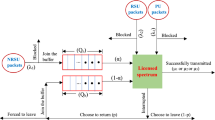Abstract
In order to resolve the issues of channel scarcity and low channel utilization rates in cognitive radio networks (CRNs), some researchers proposed to the idea of “secondary utilization” for the licensed channels. In “secondary utilization”, secondary users (SUs) opportunistically take advantage of unused licensed channels, thus guaranteeing the transmission performance and quality of service (QoS) of the system. Based on the channel vacation scheme, we analyze a preemptive priority queueing system with multiple synchronization working vacations. Under this discipline, we build a three-dimensional Markov process for this queueing model. Through the analysis of performance measures, we obtain the average queue length of two types of users, the mean busy period and the channel utility. Finally, by analyzing several numerical experiments, we demonstrate the effect of the parameters on the performance measures.
Access this chapter
Tax calculation will be finalised at checkout
Purchases are for personal use only
Similar content being viewed by others
References
Kolodzy, P.: Spectrum policy task force: finding and recommendations. Int. Symp. Adv. Radio Technol. 96(4), 392–393 (2003)
Yu, H., Tang, W., Li, S.: Joint optimal sensing time and power allocation for multi-channel cognitive radio networks considering sensing-channel selection. Sci. China Inf. Sci. 57(4), 1–8 (2014)
Zhao, Y., Jin, S., Yue, W.: Performance optimization of a dynamic channel bonding strategy in cognitive radio networks. Pac. J. Optim. 9(4), 679–696 (2013)
Wu, K., Wang, W., Luo, H., Yu, G., Zhang, Z.: Optimal resource allocation for cognitive radio networks with imperfect spectrum sensing. In: 71st Vehicular Technology Conference (VTC 2010-Spring), pp. 1–4. IEEE (2010)
Kim, K.: T-Preemptive priority queue and its application to the analysis of an opportunistic spectrum access in cognitive radio networks. Comput. Oper. Res. 39(7), 1394–1401 (2012)
Neuts, M.: Matrix-Geometric Solutions in Stochastic Models. The Johns Hopkins University Press, Baltimore (1981)
Acknowledgements
This work was supported in part by the National Natural Science Foundation (No. 61472342), Natural Science Foundation of Hebei Province (No. A2018203088), Key Foundation of Higher Education Science and Technology Research of Hebei Province (No. ZD2017079), Youth Foundation of Higher Education Science and Technology Research of Hebei Province (No. QN2016016), China, and was supported in part by MEXT, Japan, and was supported in part by MEXT and JSPS KAKENHI Grant (Nos. JP17H01825 and JP26280113), Japan.
Author information
Authors and Affiliations
Corresponding author
Editor information
Editors and Affiliations
Rights and permissions
Copyright information
© 2018 Springer International Publishing AG, part of Springer Nature
About this paper
Cite this paper
Wang, W., Ma, Z., Yue, W., Takahashi, Y. (2018). Performance Analysis of a Dynamic Channel Vacation Scheme in Cognitive Radio Networks. In: Takahashi, Y., Phung-Duc, T., Wittevrongel, S., Yue, W. (eds) Queueing Theory and Network Applications. QTNA 2018. Lecture Notes in Computer Science(), vol 10932. Springer, Cham. https://doi.org/10.1007/978-3-319-93736-6_14
Download citation
DOI: https://doi.org/10.1007/978-3-319-93736-6_14
Published:
Publisher Name: Springer, Cham
Print ISBN: 978-3-319-93735-9
Online ISBN: 978-3-319-93736-6
eBook Packages: Computer ScienceComputer Science (R0)




